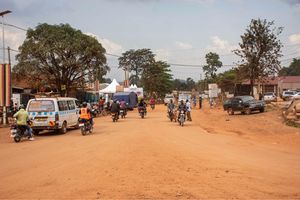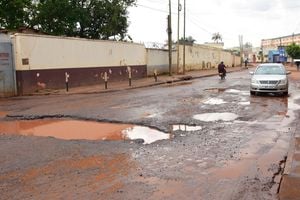Prime
Why Busoga Diocese lacks official house for Bishop 50 years later

Busoga Bishop Paul Moses Samson Naimanhye, Archbishop Samuel Stephen Kaziimba Mugalu, former Busoga Diocese Bishop Michael Kyomya and his wife Florence Kyomya pose for a group photo at Bugembe Cathedral. PHOTO/ TAUSI NAKATO.
What you need to know:
- Dr Frank Nabwiso, who was present during Bishop Bamwoze’s consecration, during an interview on Tuesday said the Busoga Lukiiko (Parliament) passed a resolution giving part of its land to the Anglican Church in 1958 during the Kyabazingaship of Henry Wako Muloki, but this resolution has not been implemented to-date.
For the past 50 years, Busoga Diocese has lacked an official residence for the Bishop, eroding a key requirement that led to it being gazetted.
Subsequently, Archbishop of the Church of Uganda, Samuel Kaziimba Mugalu, announced that he will not organise an election for a substantive Bishop once Rt Rev Paul Samson Naimanhye’s ten-year tenure ends in 2025.
“I can’t send you a Bishop and you rent for him; I will instead give you a caretaker until you build a Bishop’s house,’’ Archbishop Kaziimba said recently while addressing a congregation at Christ’s Cathedral Bugembe, in Jinja North City Division.
Busoga Diocese officially started in 1972 with the late Bishop Cyprian Bamwoze being consecrated as the first Bishop until 1999 when he was replaced by Bishop Michael Kyomya.
Dr Frank Nabwiso, who was present during Bishop Bamwoze’s consecration, during an interview on Tuesday said the Busoga Lukiiko (Parliament) passed a resolution giving part of its land to the Anglican Church in 1958 during the Kyabazingaship of Henry Wako Muloki, but this resolution has not been implemented to-date.
“Recently, I was meant to understand that Bishop Naimanhye spearheaded a fundraising drive that collected about Shs250 million, but the disagreement over land ownership between Busoga Kingdom and the Church left the project implementation hanging in balance,” Dr Nabwiso added.
The contentious land ownership issue, Dr Nabwiso says, has held the Diocese’s development goals behind because nothing can be done on the land adjacent to the Kingdom headquarters without consent from the monarchy.
Dr Nabwiso further explained that when an official palace for the Kyabazinga was constructed atop Igenge Hill, his house was turned into the Bishop’s, which was later changed to Diocesan offices.
The decision to transfer Kyabazinga’s house from the Bugembe community to Igenge Hill was hinged on the presumption that Bugembe was likely to degenerate into a slum and, therefore, unbefitting for a King to stay.
“Bishop Bamwoze vacated Kyabazinga’s house which had been gazetted for Bishops after the murder of Bishop Janani Luwum, which later led to its being phased out summarily.
“Bishop Bamwoze decided to go and stay in his home district of Kamuli where most developments were concentrated instead of bringing them on Church land in Bugembe,” Dr Nabwiso.
“Bishop Bamwoze, who was a staunch UPC supporter, lived in Naminage Village, expanded to Nakimegere Village, and later to Nakakabala Village, all in Kamuli District.
“So, he was not interested in building a new house for the Bishop, while Bishop Kyomya preferred staying in a rented house on Wanyama Road in Bugembe Ward,” said Dr Nabwiso.
When contacted, Bishop Naimanhye referred this publication to Dr Nabwiso for details concerning the Diocese’s lack of an official residence for the Prelate. “You can call Dr Nabwiso to talk about this issue because I have been in office for a short period of time.”
Bishop Naimanhye, however, revealed that for the small period he has been serving as Bishop of Busoga Diocese, he has been able to form a Sacco, construct a health centre and Archdeaconry House for the Church.
Busoga Kingdom State Minister for Lands, Mr Fred Kyangwa, said all land belongs to the monarchy, but they donated 50 acres of it to the Church for development, while the remaining 28 acres belong to the Kyabazingaship.
“When monarchies were abolished, the Kingdom utilised the other surrounding land yet only 50 acres were donated to the Church and 28 (acres) belong to the Kingdom. We had courts, prisons and police all on the same (Kingdom) land,” said Mr Kyangwa.
He, however, added that if the Church needs more land for the construction of an official residence for the Bishop, they can discuss with the Kyabazinga following the known procedure.




